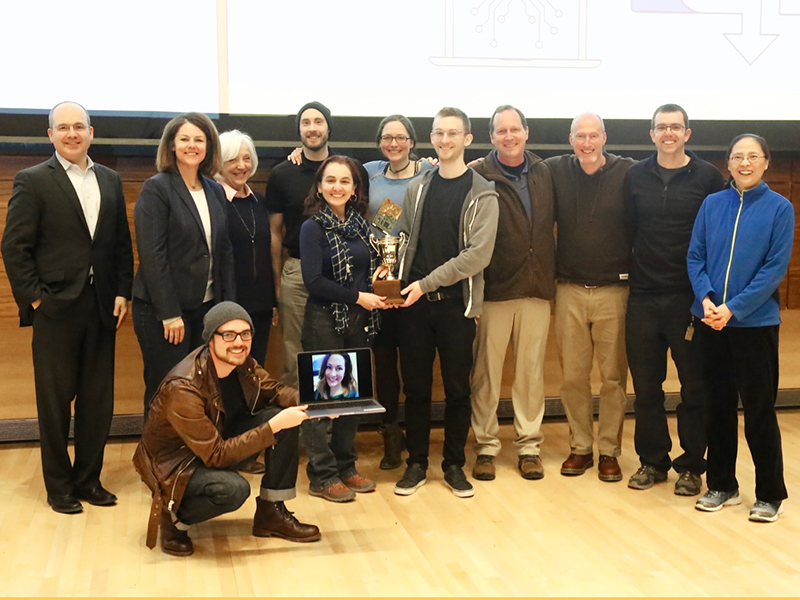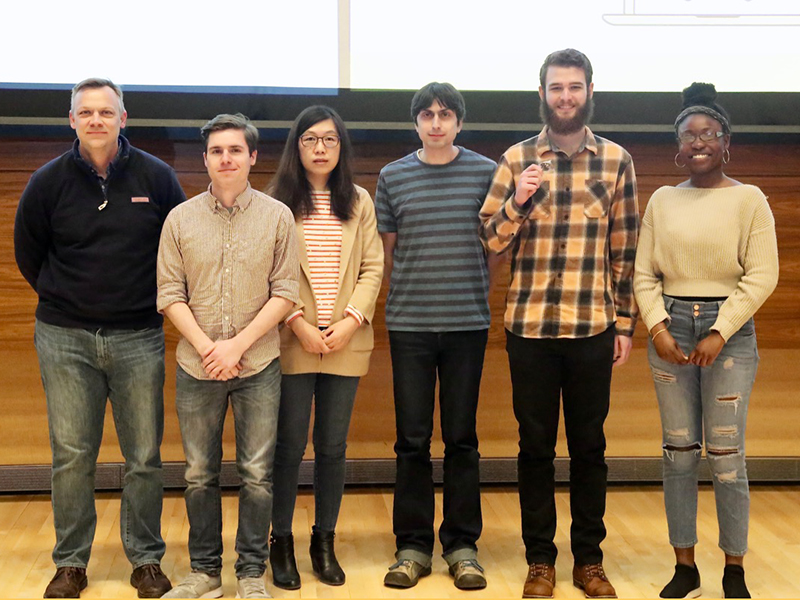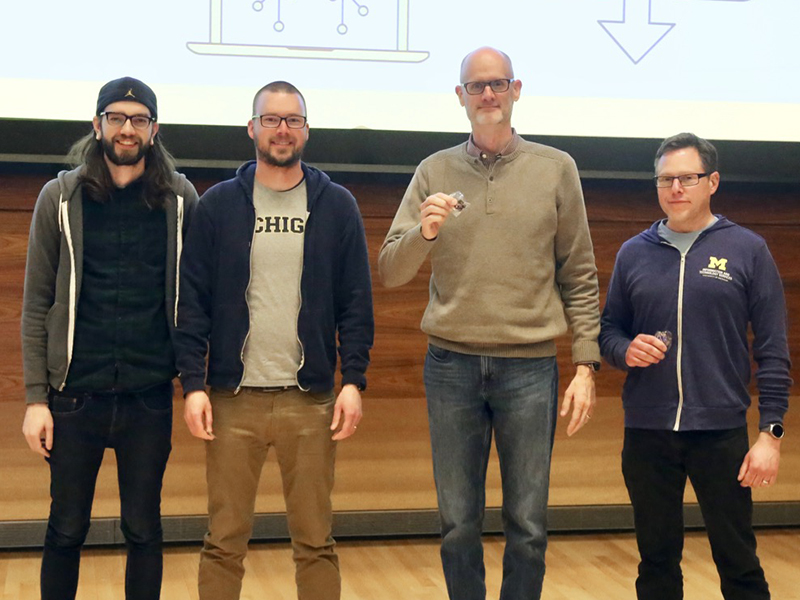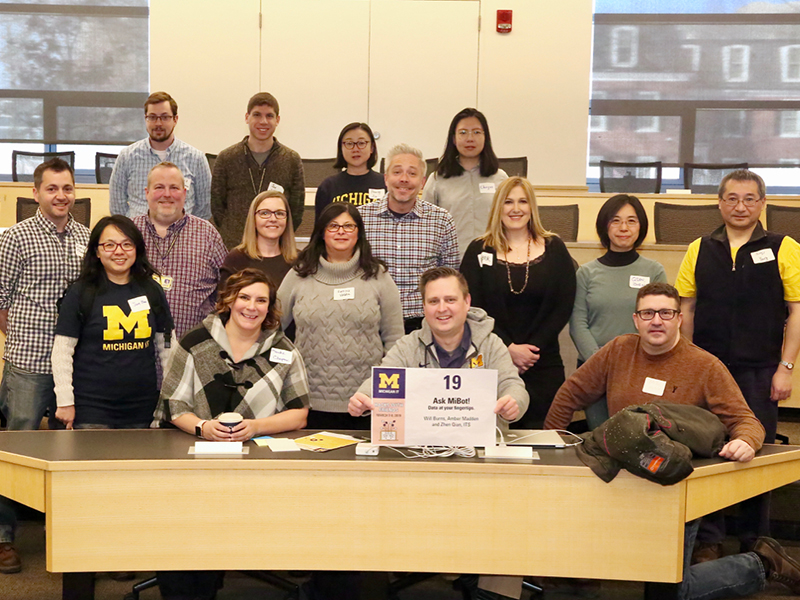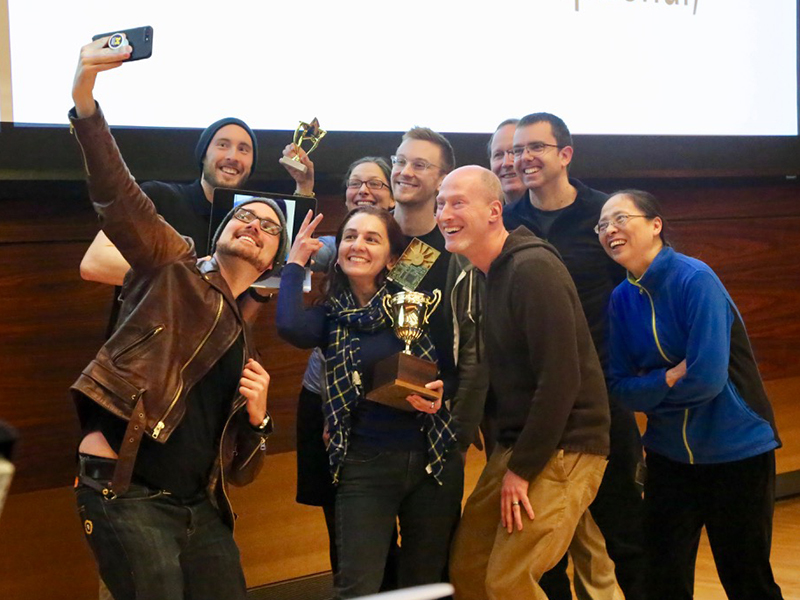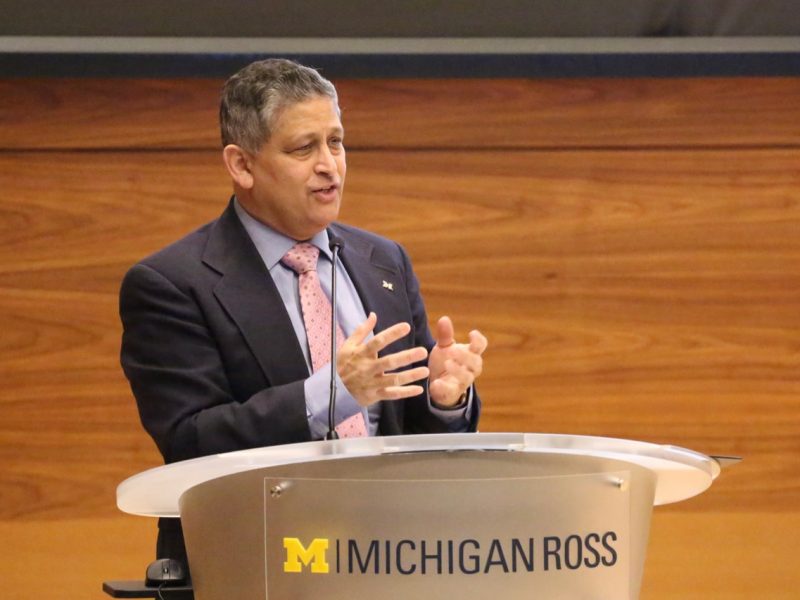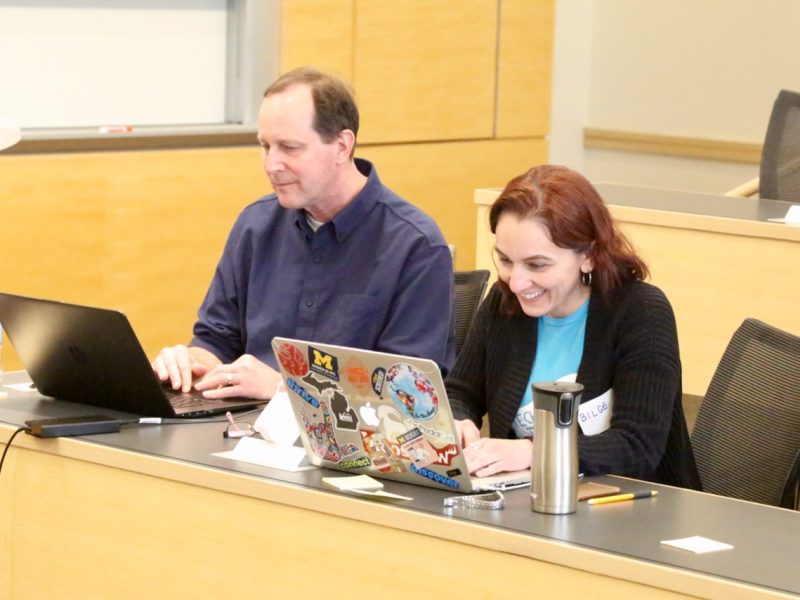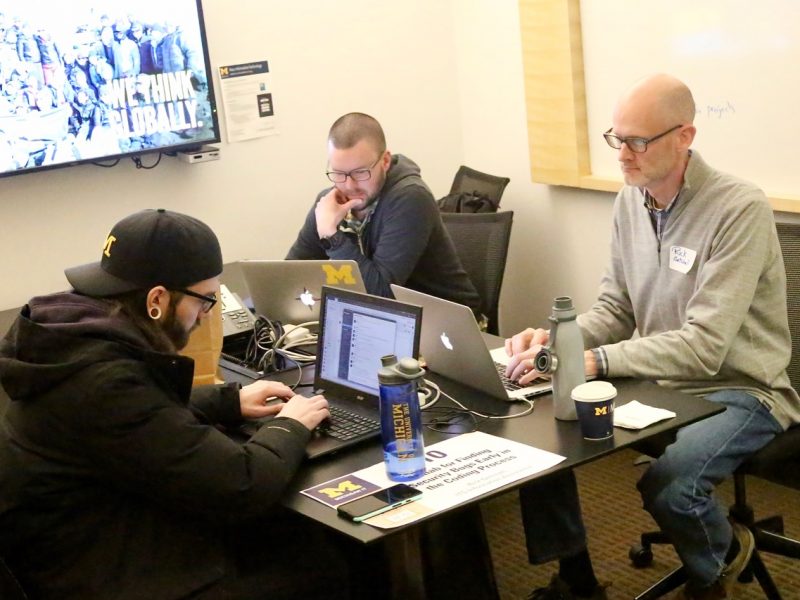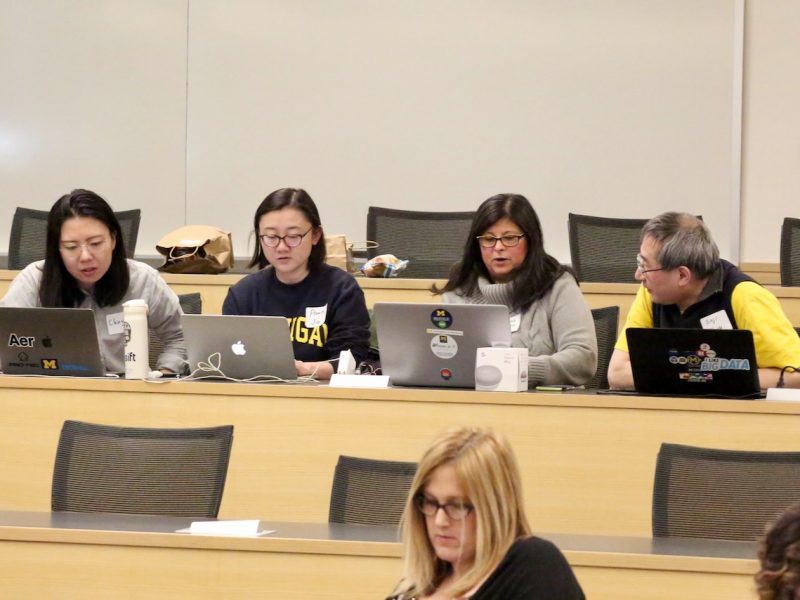A spirited, two-day event called Hacks with Friends brings together IT professionals across campus to innovate and quickly solve technology problems. Along the way, they make connections that last.
On March 7–8, 2019, over 140 participants collaborated to build 18 projects over two days. Many teams recruited across organizations and combined skills that spanned the IT spectrum, including developers, web designers, data analysts, user experience experts, and business analysts. Twenty-five volunteers helped produce the event, including 13 at the Genius Bar, a support desk that helped teams with technical issues like hosting, cloud storage, data integration, and more.
A sustained effort
At the start of the event, VPIT-CIO Ravi Pendse made opening remarks and encouraged the group to sustain projects after the short event is done. “I greatly appreciate the group gathering to explore new ideas, innovate, and create something that will benefit the entire university.” He also used the phrase “hack with us” as he suggested the possibility of expanding the future audience for the event to include U-M faculty and students in addition to IT professionals.
“Hacks with Friends is about exploring new ideas, innovating, and creating something that will benefit the entire university.”
Ravi Pendse
Making a judgment call
While 18 teams participated, just four were voted into the final judging round. Peer voters texted in their three favorite teams after watching short presentations.
When the judges arrived, it was time to get serious: A golden hard drive was at stake. The final four teams polished and lengthened their pitches to 10 minutes each. Some improved their tech demos to better show off what their apps could do. This year, the judges were:
- Andrew Rosenberg, M.D.; Associate Professor of Anesthesiology & Internal Medicine; Chief Information Officer for Michigan Medicine
- Catherine Curley, Chief Information Officer for the College of LSA
- Marcelline Harris, PhD, RN; Associate Professor of Nursing, School of Nursing; Department of Systems, Populations and Leadership
“In the past, judging was easier,” said Rosenberg. “When it came down to the final projects, all four teams this year demonstrated a product that worked in some way.”
“The speed with which diverse teams can produce a minimum viable product that really works in a day and a half, and make it presentable, is remarkable. The differences are in subtle and subjective ways.”
“The speed with which diverse teams can produce a minimum viable product that really works in a day and a half, and make it presentable, is remarkable.”
Andrew Rosenberg
Curley also added: “Fantastic work to all of the teams. It was really amazing to see how the work has progressed and to see how it builds on the investments U-M has made in the last few years.”
First place: ContaMiNot
A sustainability app to help you determine which bin your trash should go into

When faced with multiple bins, where do you put your trash? This team set out to address that problem by building a prototype for a waste disposal app that uses object recognition & machine learning. It works by using the Core ML Framework to identify a piece of trash with a smartphone camera, then the app interface instructs the user which bin to use.
Beyond technical prowess was the team’s vision and commitment to environmental impact—an effort to prevent contamination and educate about waste disposal. Team leader Jule Krüger led presentation pitches with what’s at stake—our oceans are filling with plastic, and contamination at landfills creates methane, one of the worst greenhouse gases.
“ContaMiNot connected their project to a U-M strategic goal to reduce landfill waste by 40% by 2025. We really appreciated that.”
Cathy Curley
What’s next? The team has ambitions to add game-like elements to the experience by allowing users to track their statistics and quantify how much trash they have helped to keep out of a landfill.
More resources
The team hosted a website at contaminot.fo.umich.edu with more information, including a wealth of project documentation like GitLab repository, presentation slides, and lessons learned.
Judges remarks
- Cathy Curley: “ContaMiNot connected their project to a U-M strategic goal. We really appreciated that. Will people really take their phones out to scan objects? I think they will.”
- Marcelline Harris: “What appealed to us: Thinking locally, but acting globally. It seemed like a very altruistic initiative. This app offers opportunity. Personally, I cannot interpret the images on these [waste] containers.”
- Andrew Rosenberg: “It’s not just tech with cool features, object recognition, and machine learning, but about technologists thinking about social change as well. These are issues we need to think about as part of Michigan IT.”
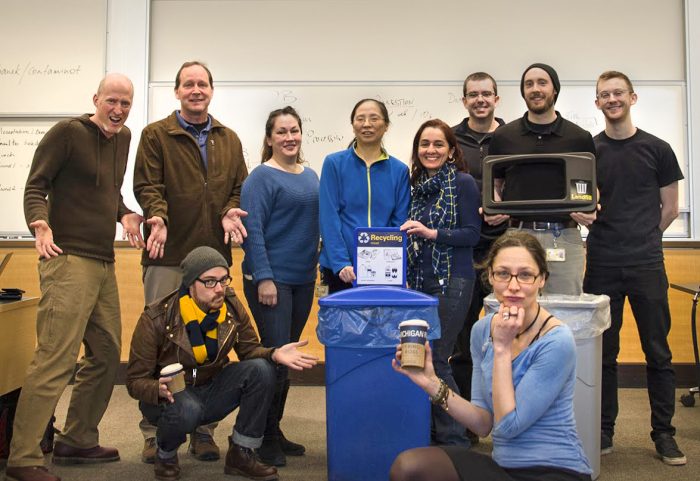
Team ContaMiNot was led by Jule Krüger (ISR) and A. Bilge Ozel (Medical School) and included a total of 10 staff from CAEN, HITS, ITS, LSA-TS, and OUD. For a complete list, see the Hacks With Friends website.
Second place: U-M StudySpace
An app that helps students find and reserve an appropriate study room
Finding a location to study can be a time-consuming challenge for student groups. Students often ask, ‘How can I find available study rooms nearby?’ Even if they are available, they can’t be sure whether the space is quiet or whether the room has the features they need to do their work.
The U-M StudySpace team created an elegant solution. It’s a prototype for a mobile app that allows campus users to identify available and suitable study rooms nearby, then make a reservation. The system makes smart use of users’ locations to serve up relevant data based on distance. It also has filters for room availability, room type, room features, capacity, and even noise level.
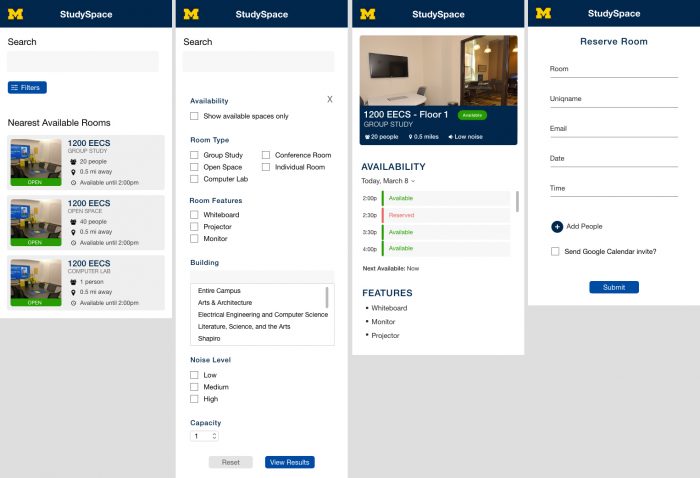
The team’s stretch goals are to add U-M authentication and Google Calendar integration to add meeting collaborators. The system could also be used to reserve other spaces across campus, like conference rooms, if the data sources could be identified and connected. The app currently uses databases that serve information about lab reservations, room details, room coordinates, and classroom schedules.
“You can see how StudySpace could be used across U-M, and how it could scale to address many challenges.”
Andrew Rosenberg
Judges praised U-M StudySpace for its completeness. “I wanted to start using it,” said Rosenberg. “You can see how it could be used across every aspect of U-M, and how it could scale for pragmatic use to address many challenges. We were impressed with the architecture they showed.”
Team StudySpace included a total of six staff from CAEN, CLASP, and ITS, For a complete list, see the Hacks With Friends website.
Third place: GitLab for Finding Security Bugs Early in the Coding Process
An application security test for developers
This team produced just what their title promised: A means for software developers to quickly and easily identify security vulnerabilities early, before they become a serious risk to institutional data.
They developed a static application security test that combs through lines of code. It scans for for poor practices and exploitable areas that could present an opportunity for bad actors. Their goal? Minimize the unintentional delivery of insecure code into U-M’s production environment.
Call it the hacker’s hack. Their goal was to minimize the unintentional delivery of insecure code into U-M’s production environment.
It’s fair to say this was the hacker’s hack. At Hacks with Friends, this project was popular because it set out to make people’s lives easier. The judges could sense it, too: “I don’t think there’s a better compliment than when other peers ask for your service,” said Rosenberg. “It sounds like people want it right now.” [Consider that confirmed by a GIF presented during the team’s pitch of Michigan IT developer Kris Steinhoff.]
Team GitLab for Security included a total of four staff from Information Assurance and ITS. For a complete list, see the Hacks With Friends website.
Fourth place: Ask MiBot! Data at your fingertips
A personal assistant designed to make life on campus easier for U-M students
Students are used to getting instantaneous answers from intelligent assistants like Siri, Alexa, and Google Assistant. Why can’t they ask about university-specific data like course assignments, dining, parking, and buses?
Team MiBot set out to address this problem and create the next generation of personal assistant for students at U-M. They invented a student persona named Maizy Blue, a U-M freshman, whose motivations and goals informed the development objectives: Maizy wants to be on time to class, stay organized and healthy, and make the best decisions about eating and transportation on campus.
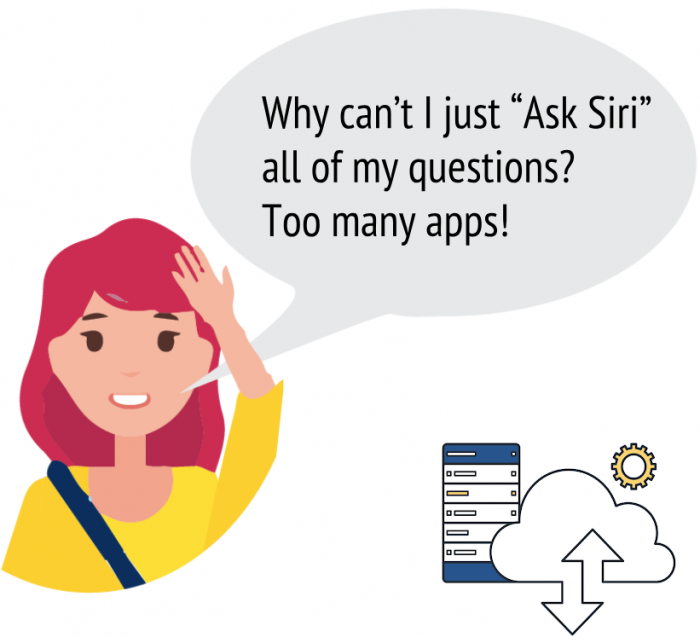
MiBot will provide instant answers with the ability to ask questions through a Google-like search box, or out loud to device like Echo or Google Home. Using a student persona, MiBot will answer common questions, leveraging Google Cloud Services for Natural Language Processing and U-M API directory services to aggregate information from U-M servers.
MiBot uses Google’s DialogFlow service, a powerful AI platform that can interpret natural voice and text input from users, and use machine learning to associate that input with user intent. From there, lots of things can happen—fetching real-time data about Canvas courses or parking space availability, for example—before the agent responds with a useful response (textual or verbal).
The judges felt that harnessing multiple datasets was impressive, and strongly recommended that the team stay together and keep working on it.
Team MiBot included a total of 16 people, including two graduate students and 14 staff from CoE, LSA, HITS, and a variety of departments in ITS. For a complete list, see the Hacks With Friends website.

